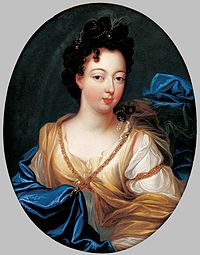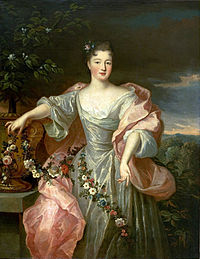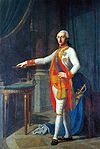- Charlotte Aglaé d'Orléans
-
Charlotte Aglaé d'Orléans 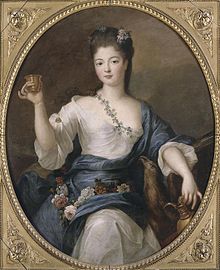
Charlotte Aglaé as Hebe, by Pierre Gobert Duchess of Modena Consort 26 October 1737 – 19 January 1761 Spouse Francesco III, Duke of Modena Issue Maria Teresa, Duchess of Penthièvre
Ercole Rinaldo, Duke of Modena
Maria Fortunata, Princess of Conti
Benedetto Filippo, Abbot of AnchinFull name Charlotte Aglaé d'Orléans Father Philippe d'Orléans, Duke of Orléans Mother Françoise Marie de Bourbon Born 20 October 1700
Palais-Royal, Paris, FranceDied 19 January 1761 (aged 60)
Petit-Luxembourg, Paris, FranceBurial Val-de-Grâce, Paris, France Signature 
Charlotte Aglaé d'Orléans, (20 October 1700 - 19 January 1761) was the Duchess of Modena and Reggio by marriage. She was the third daughter of Philippe d'Orléans, (successively, the Duke of Chartres, the Duke of Orléans, and eventually the Regent of France from 1715 to 1723), and of his wife, Françoise-Marie de Bourbon. She was born a princesse du sang. When a married women, she had ten children.
Contents
Youth
Charlotte Aglaé d'Orléans was born at the Palais-Royal, her parents' residence in Paris. As a young child, Charlotte Aglaé was known at court as Mademoiselle de Valois. Her second name comes from the youngest of the three Greek Charites; Aglaea.
At a young age, she and Louise Adélaïde were placed in the Abbey of Chelles, which her sister would years later 'rule' as abbess. Charlotte Aglaé was one of eight children. In 1714, she was sent by her parents to Val-de-Grâce Abbey.
At that time, her marriage became the preoccupation of her family. Her older sister, the Duchess of Berry suggested that she marry the young Louis Armand de Bourbon, Prince of Conti, the son of François Louis, Prince of Conti and of his wife Marie Thérèse de Bourbon, but Louis XIV would not give his consent to the union.
In 1715, Charlotte Aglaé moved into the Palais-Royal with her family. The following year, her mother suggested her marriage to her first cousin, Louis Auguste de Bourbon, prince de Dombes, son of her uncle, Louis Auguste de Bourbon, duc du Maine, but Charlotte Aglaé refused. Shortly thereafter, Charlotte Aglaé went to live at the Château de Saint-Cloud with her paternal grandmother, Elizabeth Charlotte of the Palatinate, the Dowager Duchess of Orléans who was known as Madame at court. Her grandmother made a pen portrait of her granddaughter at this time:
Mademoiselle de Valois is not, in my opinion, pretty, and yet occasionally she does not look ugly. She has something like charms, for her eyes, her colour and her skin are good. She has white teeth, a large, ill-looking nose, and one prominent tooth, which when she laughs has a bad effect[1]
The Dowager Duchess of Orléans also said of her granddaughter that:
She has a good deal of the Mortemart family in her, and is as much like the Duchess of Sforza, the sister of Montespan
Her cousin, Louis Henri, Duke of Bourbon, proposed to her on behalf of his younger brother, Charles de Bourbon, comte de Charolais. Charlotte Aglaé is said to have seriously considered the proposal but her parents refused outright.
In 1718, Charlotte Aglaé began a romantic affair with Louis François Armand du Plessis, duc de Richelieu.[2] In 1719, the duke was arrested and jailed in Hem in connection with his participation in the Cellamare Conspiracy. Charlotte Aglaé visited the duke several times in prison. Wishing to marry him, she urged her father, the Regent, to pardon him.
Her older cousin, Louise Anne de Bourbon, was another of the promiscuous Richelieu's conquests. The cousins, who had never been very close, became bitter enemies due to their simultaneous romantic involvement with the womanising duke. This enmity continued long after each amorous affair had ended. The young Louise-Anne was considered the most attractive daughter of Louis III, Prince of Condé.
-
Mother in the year of her birth
Marriage
Against Charlotte Aglaé's wishes, the Regent accepted an offer of marriage for his daughter that was proffered by Rinaldo d'Este, Sovereign Duke of Modena for his son and heir, Prince Francesco d'Este. Earlier projects to marry Charlotte Aglaé to either an English prince or to Charles Emmanuel III of Sardinia had failed. Her grandmother is known to have written to Charlotte Aglaé's aunt, Anne Marie d'Orléans, Queen of Sicily, on the marriage proposal. As a pre-condition to the liberation of Richelieu, her lover, it was decided that she would marry the heir of Modena.
According to her grandmother's writings, her future husband had fallen in love with the young Charlotte Aglaé upon, "the mere sight of her portrait".[3]
Few expected the marriage to succeed, as Charlotte Aglaé had no desire to leave France. Her distant cousin, Marguerite Louise d'Orléans, who had previously been wedded against her will to Cosimo III de' Medici, Grand Duke of Tuscany in 1661, had suffered through a disastrous marriage. Eventually, Marguerite was forced to return to France in disgrace. People assumed that the same fate awaited Charlotte Aglaé. The Grand Duchess noticed the similarities between herself and her younger cousin and, unable to deal with the situation, refused to speak to Charlotte Aglaé about her impending nuptials:
the Grand Duchess of Tuscany says that she will not see Mademoiselle de Valois nor speak to her, knowing very well what Italy is, and believing that Mademoiselle de Valois will not be able to reconcile herself to it. She is afraid that if her niece should ever return to France they will say, "There is the second edition of the Grand Duchess".[4]
The original date for the marriage was 25 January 1720, but this date was postponed till the next month due to an oversight by the Bishop of Modena. Despite this, the marriage certificate was signed on 31 January.
On 11 February 1720, a proxy marriage was performed at the Tuileries Palace.[5] Her brother, the Duke of Chartres stood in for his future brother-in-law, while her younger sister Louise Élisabeth held her train. After this, there was a banquet at the Palais Royal where the young king Louis XV attended and presented his gifts to the new Hereditary Princess of Modena.
Modena
Charlotte Aglaé set off first for Antibes and next Genoa.
Arriving in Reggio on 20 June, she met her father-in-law, husband and brother-in-law for the first time. The formal wedding ceremony took place on 21 June 1720 in Modena. Charlotte Aglaé received an enormous dowry of 1.8 million livres, half of which was contributed in the name of the young king, Louis XV, on orders of the Regent. From her adopted country, Charlote Aglaé received a trousseau consisting of diamonds and portraits of her future husband.
As her husband's mother had died in 1710, the Hereditary Princess was the most senior princess in Modena.
Although by rank she was neither a fille nor petite-fille de France, Charlotte Aglaé was allowed to keep the Duchess of Villars in attendance as a lady-in-waiting at the Modenese court. The Duchess of Villars was there to represent the French king.
In Modena, Charlotte Aglaé grew bored and lonely. Her father-in-law, with whom she got on rather well, was a dull man ruled by monks and his favourites. The court at Modena was said to have been more of a convent then a court.
Everyone was expected to rise very early and attend Mass; dinner was served at an hour when many of the fashionable ladies of Paris and Versailles were sipping their morning chocolate; the usual occupation of the ducal family in the afternoon was a carriage ride, the carriages proceeding at an almost funeral pace; supper was at eight o'clock ; and ten was bed time. Her boredom was only agitated when her father-in-law's favourite, the Count of Salvatico (an admirer of Charlotte Aglaé) was made Grand Master of Ceremonies. The count used his new position to claim the right of entering the princess's apartments at any time he wished. He intercepted her mail from relatives and friends in France, and actually had the audacity to stop delivery of several letters from her father, in order to create the impression that she had quarrelled with the Regent. In addition, he furnished blind and lame horses for her carriage and pewter for her table. In short, he tried to annoy her as much as possible.[6]
In order to distract herself from the boring court, Charlotte Aglaé began holding small private gatherings in her apartments where she would entertain a small circle attended by her husband's three surviving sisters including Enrichetta d'Este, future Duchess of Parma.
In September 1720, Charlotte Aglaé caught smallpox and, according to her grandmother, the last sacrements were administered. She called her French confessor, Colibeaux, to her bedside, and, handing him a casket, directed him to secretly burn all the papers which it contained. Probably among these papers were the love-letters which she had received from the Duke of Richelieu. During this illness, her husband was forbidden to see her; he stayed at his villa at Sassuolo until she recovered. Soon the marriage was criticised for not having produced any children, and blame fell upon the then recovering princess.
This criticism of the couple led them to flee to Verona for a short spell, much to the annoyance of her father-in-law. In retaliation, he cut off the postal service to the prince and princess in the hope that they would return. It was at this time that Charlotte first asked her father to let her return to France and live at Versailles with her family. This request only served to complicate marriage plans already under way for her younger sisters Louise Élisabeth and Philippine Élisabeth. In December 1723, while she was away in Italy, her father died. Her younger brother, Louis, succeeded to the Orléans titles.
Following her father's death, Charlotte Aglaé and her husband were asked to stay at the prince's villa at Reggio, in a sort of private exile away from the court of Modena.
In 1727, her former lover, the Duke of Richelieu, visited her in Modena in disguise, and the two resumed their romantic affair[citation needed]. When this was exposed, her husband allowed her to return to France in temporary disgrace. She returned to Modena later in 1727. The next year, 1728, she and her husband fled to Genoa; five years later in 1733, she returned to France where she found herself unwelcome; her mother, who had never liked her, was cold; her closest friend in the family was her illegitimate half-brother, the chevalier d'Orléans.
In 1733, the War of the Polish Succession broke out. Despite her father-in-law declaring himself neutral, the ducal family still found their home being occupied by foreign armies.
As a result, the Duke of Modena went to Bologna while his son and Charlotte Aglaé travelled to France where they stayed in Lyons. Her mother, trying to keep her scandalous daughter away from Paris and Versailles, wrote to the Duke of Modena to make sure that Charlotte Aglaé and her husband stayed in Lyons. Her younger brother, Louis, Duke of Orléans, did the same. The next year, after much correspondence on her husband's part with the French court, the two were allowed to go to Paris incognito. They arrived on 12 March 1734. Her arrival at the Palais-Royal was a cold one. She met her mother and brother, neither of whom even bothered to offer her any accommodation or refreshment.
Initially, she and her husband lived at the Hôtel de Luynes Rue du Colombier (where her son Benedetto was born), not far from the Abbey of Saint-Germain-des-Prés. Soon after, they moved to the Hôtel de Lyon, in the Rue des Petits-Champs, which was much closer to her brother's residence, the Palais-Royal. Her brother gave her the small sum of 25,000 écus during her stay in Paris, but he refused to help in any other way.
In 1735 her husband was recalled to Modena on matters of state. Charlotte Aglaé used her looks to influence her cousin, the young king, to let her stay after her husband's departure. This was done on the condition that she stay away from the court and live at the Val-de-Grâce convent of her childhood. As a result of manipulations by her mother and brother, she was never allowed to be received by the queen, Maria Leszczyńska. It was always maintained that such a public event would cause too much damage by exposing her incognito status. Her husband returned in May 1736.
Much to the annoyance of her family, Charlotte Aglaé and her husband remained in Paris. A dramatic argument followed in which Charlotte Aglaé and her sister, the Dowager Queen of Spain, squabbled over a question of etiquette. When her family took the Dowager Queen's side completely, Charlotte Aglaé became even further isolated.
Sometime after, her husband had to go to Hungary. Charlotte Aglaé persuaded Cardinal Fleury to convince the young king to once again let her stay in Paris and not depart with her husband. The cardinal also convinced her family into accepting her continued presence in France.
Upon the death of her father-in-law in 1737, her husband became Francesco III, reigning Duke of Modena. Despite Charlotte Aglaé's new rank as the wife of a Sovereign Prince, she did not receive any better treatment in France. Family relations were further worsened when Charlotte Aglaé and her brother engaged in a trivial lawsuit regarding some family property.
In June 1739, she reluctantly returned to Modena. In an attempt to make the place fashionable, she promoted the arts. She introduced a French-style theatre to Modena, which was a great success. She also added a corps de ballet to the city in which she took great pride. Her husband also made several additions to the Ducal Palace of Modena, including a large hall which was an exact replica of one at the Tuileries Palace. During their marriage, her husband amassed one of the finest portrait collections in Italy.
In 1741, her eldest son, Ercole, the ducal heir, married Maria Teresa Cybo-Malaspina (1725–1790). She was the daughter of Alderano Cibo-Malsapina, Duke of Massa and his wife Ricciardia Gonzaga di Novellara. Maria Teresa had become the Duchess of Massa and Cararra in her own right in 1731 upon the death of her father. The young couple would later have two children who survived into adulthood.
In 1743, due to the War of the Austrian Succession, Charlotte Aglaé was forced to ask for permission to return to Paris with her eldest daughter, Maria Teresa. This request was at first ignored but help came from her old lover, the Duke of Richelieu, who used his influence over Louis XV's current mistress, the Duchess of Châteauroux, to gain the necessary approval. When she arrived in Paris, she was greeted with all of the honours owed her due to her rank.
She was now a stout, red-faced woman, looking rather like her father. She lived on the Rue de Grenelle in the Faubourg Saint-Germain and became a friend of the Duchess of Châteauroux.
Upon the death of Duchess of Châteauroux, her influence dwindled for a time. In 1744, however, she was able to secure for her daughter, Princess Maria Teresa of Modena, a marriage to the Duke of Penthièvre, the richest noble in France. Louis Jean Marie de Bourbon, was Charlotte Aglaé's younger first cousin and was the heir to the vastly wealthy House of Bourbon-Penthièvre. The couple married happily in 1744 and had two surviving children. Their eldest child, the Prince de Lamballe, married Maria Teresa Luigia di Savoia, the future friend of Marie Antoinette, in 1767. Their second child, Louise Marie Adélaïde de Bourbon, married the Duke of Chartres, (known as Philippe Égalité during the French Revolution of 1789) and later became the mother of Louis-Philippe I, King of the French.
At Maria Teresa's death in 1754, Monsieur de Penthièvre travelled to Italy where another of Charlotte Aglaé's daughters was proposed, the Princess Matilde. Penthièvre refused and never remarried.
This advantageous marriage by her daughter allowed Charlotte Aglaé to have some say in French politics for a short period. Things began to change when Madame de Pompadour was presented at court in 1745. After the Treaty of Aix-la-Chapelle was signed in 1748, Charlotte Aglaé did not return to Modena. By 1754, it seemed that she had lost her flare at Versailles.
Despite this, she did manage to secure a French marriage for her fourth daughter, Princess Maria Fortunata. Maria Fortunata, like her older sister, married one of her mother's cousins, Louis François II de Bourbon, Prince of Conti. He was the last prince de Conti. The marriage proved very unhappy, to the point where the groom did not want to live any longer with his wife.
Charlotte Aglaé finally returned to Modena in 1759. There, she discovered that her husband had eloped with one Marchesa Simonetti, a widow of 60. She decided to leave the old couple to their own devices and began travelling extensively around Europe. She died in Paris at the Petit Luxembourg, where her two of her sisters, the old Duchess of Berry and Dowager Queen of Spain, had previously died. Her heart was placed in the Church of Val-de-Grâce but was removed and lost during the French Revolution. After her death, her husband remarried twice more morganatically to Teresa Castelberco and Renata Teresa d'Harrach.
Her body was buried at the Val-de-Grâce Abbey where she had spent some of her youth.
Issue
Name Portrait Lifespan Notes Prince Alfonso 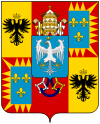
18 November 1723 -
16 June 1725,died in infancy at Ducal Palace of Reggio Prince Francesco Constantino 
22 November 1724 -
16 June 1725born at the Ducal Palace of Reggio, he died in infancy Princess Maria Teresa Felicita
Duchess of Penthièvre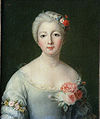
6 October 1726 -
30 April 1754born at the Ducal Palace of Modena, Modena, she wed Louis Jean Marie de Bourbon, Duke of Penthièvre and had issue; was mother in law of Philippe Égalité and the Princesse de Lambelle and the maternal grandmother of Louis-Philippe I, King of the French; she died in childbirth at the Château de Rambouillet, France aged 27 Prince Ercole Rinaldo
Duke of Modena and Reggio22 November 1727 -
14 October 1803born at the Ducal Palace of Modena, he succeeded his father as the Duke of Modena and Reggio. Married Princess Maria Teresa Cybo Malaspina heiress of Massa and Carrara; had issue (Maria Beatrice Ricciarda d'Este) became the heiress of Modena, Reggio, Massa and Cararra and married Archduke Ferdinand of Austria in 1777. The couple founded the modern House of Austria-Este; he died in Treviso and was buried at the Convent of the Visitation in Venice Princess Matilde 
7 February 1729 -
14 November 1803born in Genoa, she died in Treviso aged 74 Princess Beatrice 
14 July 1730 -
12 July 1731born in 1730, she died at Reggio two days before her 1st birthday Princess Beatrice 
24 November 1731 -
3 April 1736born at the Ducal Palace of Modena, she died in the same palace aged 4 Princess Maria Fortunata
Princess of Conti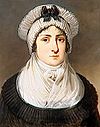
24 November 1731 -
21 September 1803born at the Ducal Palace of Modena, she wed Louis François de Bourbon, Prince of Conti; had no issue and died in Venice, Italy; was buried at the Convent of the Visitation in Venice Prince Benedetto Filippo
Abbot of Anchin
30 September 1736 -
16 September 1751born at the Hôtel de Lyon in Paris during his mother's "escape", he was made Abbot of Anchin; little else is known about him; he died at the Ducal Palace of Modena Princess Maria Elisabetta Ernestina 
12 February 1741 -
4 August 1774born at the Ducal Palace of Modena, little else is known of her Ancestors
Ancestors of Charlotte Aglaé d'Orléans Titles, styles, honours and arms
Styles of
Carlotta Aglae, Duchess of Modena and Reggio as consort
Reference style Her Royal Highness Spoken style Your Royal Highness Alternative style Madame Titles and styles
- 20 October 1700 – 21 June 1720: Her Serene Highness Mademoiselle de Valois (Son Altesse sérénissime Mademoiselle de Valois)
- 21 June 1720 – 26 October 1737: Her Royal Highness the Hereditary Princess of Modena
- 26 October 1737 – 19 January 1761: Her Royal Highness the Duchess Consort of Modena and Reggio (Son Altesse royale Madame la duchesse de Modène et Reggio)
References
- ^ Mémoires sur la cour de Louis XIV et de la Régence by Dowager Duchess of Orléans[page needed]
- ^ Anquetil, Histoire de France, 1820[page needed]
- ^ Elizabeth Charlotte of the Palatinate, Mémoires sur la cour de Louis XIV et de la Régence.[page needed]
- ^ Elizabeth Charlotte of the Palatinate, Mémoires sur la cour de Louis XIV et de la Régence.[page needed]
- ^ Louis de Rouvroy Saint-Simon, La Cour du Régent[page needed]
- ^ [1]
Notes
- Some information on this page is from the French Charlotte-Aglaé d'Orléans (1700-1761) site
External links
- French Memoirs of her Grand mother
- French site on her, siblings and cousins
- Picture of Charlotte as Duchess of Modena
See also
Princesses of Orléans The first generation are the children of Gaston, Duke of Orléans, son of Henry IV; the second is from Philippe, Duke of Orléans, son of Louis XIII;1st Generation Anne Marie Louise, Duchess of Montpensier^ · Marguerite Louise, Grand Duchess of Tuscany^ · Élisabeth Marguerite, Duchess of Guise^ · Françoise Madeleine, Duchess of Savoy^ · Princess Marie Anne^
2nd Generation Marie Louise, Queen of Spain^ · Anne Marie, Queen of Sardinia^ · Élisabeth Charlotte, Duchess of Lorraine^
3rd Generation Louise Élisabeth, Duchess of Berry^ · Louise Adélaïde, Abbess of Chelles^ · Charlotte Aglaé, Duchess of Modena^ · Louise Élisabeth, Queen of Spain^ · Philippine Élisabeth, Mademoiselle de Beaujolais^ · Louise Diane, Princess of Conti^
4th Generation Princess Louise Marie^
5th Generation Mademoiselle d'Orléans^ · Bathilde, Princess of Condé^
6th Generation Françoise, Mademoiselle de Chartres^ · Adélaïde, Princess of Orléans
7th Generation Louise, Queen of the Belgians · Marie, Duchess of Württemberg · Princess Françoise · Clémentine, Princess of Kohary
8th Generation Marguerite Adelaide, Princess Czartoryska · Princess Blanche · Françoise, Duchess of Chartres · Marie Isabelle, Countess of Paris · Princess Amalia · Princess Cristina · Princess Maria de la Regla · Mercedes, Queen of Spain
9th Generation Amélie, Queen of Portugal · Hélène, Duchess of Aosta · Isabelle, Duchess of Guise · Louise, Princess Carlos of the Two Sicilies · Marie, Princess Valdemar of Denmark · Margherite, Duchess of Magenta · Louise, Princess Alfons of Bavaria
10th Generation Isabelle, Princess Pierre Murat · Françoise, Princess Cristopher of Greece and Denmark · Anne, Duchess of Aosta · Marie Louise, Princess Philip of the Two Sicilies · Princess Sophie · Genieviève, Marchioness of Chaponay
11th Generation Isabelle, Countess of Schönborn-Buchheim · Hélène, Countess Evrard of Limburg-Stirum · Anne, Duchess of Calabria · Diane, Duchess of Württemberg · Claude, Duchess of Aosta · Chantal, Baroness François Xavier de Sambucy de Sorgue · Gerarda, Marchioness of Marchelina · Beatriz, Countess Tomasso Farini
12th Generation Isabelle, Princess Gundakar of Liechtenstein · Princess Blanche · Princess Clothilde, Mrs. Edouard Crépy · Princess Adélaïde, Mrs. Pierre-Louis Dailly · Diane, Viscountess Alexis of Noailles · Princess Pilar, Mrs. Nicholas Henderson-Stewart · Princess Eulalia
13th Generation Princess Thérèse Isabelle · Princess Louise Marie · Princesse Hélène · Princess Isabelle
^never styled Princess of OrléansThe generations start from the children of Charles de Bourbon Duke of Vendôme by whom all Bourbon's after c.1513;1st Generation Marie · Marguerite, Duchess of Nevers · Madeleine, Abbess of Sainte Croix de Poitiers · Catherine, Abbess of Soissons · Renée, Abbess of Chelles · Léonore, Abbess of Fontevraud2nd Generation Madeleine · Catherine, Duchess of Lorraine · Marguerite · Madeleine · Catherine3rd Generation Catherine · Éléonore, Princess of Orange · Marie · Louise, Duchess of Longueville · Marie, Princess of Carignan4th Generation 5th Generation none6th Generation Marie Louise Élisabeth, Duchess of Berry · Louise Adélaïde, Abbess of Chelles · Charlotte Aglaé, Duchess of Modena · Louise Élisabeth, Queen of Spain · Philippine Élisabeth, Mademoiselle de Beaujolais · Louise Diane, Princess of Conti · Marie Thérèse, Princess of Conti · Anne, Mademoiselle d’Enghien · Anne Marie, Mademoiselle de Condé · Louise Bénédicte, Duchess of Maine · Marie Anne, Duchess of Vendôme · Mademoiselle de Clermont · Marie Anne, Princess of Condé · Louise Adélaïde, Mademoiselle de La Roche-sur-Yon · Mademoiselle d'Alais7th Generation Marie Louise Élisabeth d'Alençon · Louise Marie · Marie Anne Éléonore, Abbess of Saint-Antoine-des-Champs · Louise Élisabeth, Princess of Conti · Louise Anne, Countess of Charolais · Marie Anne, Mademoiselle de Clermont · Henriette Louise, Mademoiselle de Sens · Élisabeth Alexandrine, Mademoiselle de Sens · Louise Henriette, Duchess of Orléans · Marie Adélaïde, Duchess of Orléans · Marie Louise, Mademoiselle de Penthièvre8th Generation 9th Generation 10th Generation 1st Generation Princess Eleanor of Naples ·2nd Generation 3rd Generation 4th Generation 5th Generation 6th Generation Maria Caterina Farnese · Vittoria Farnese · Lucrezia Barberini* · Princess Margherita of Savoy · Teresa Maria Grimaldi7th Generation 8th Generation 9th Generation 10th Generation none11th Generation 12th Generation *did not have a royal or noble title by birth
^also a princess of Modena in her own rightEleanor of Naples (1473-1493) · Lucrezia Borgia (1505-1519) · Renée of France (1534-1559) · Lucrezia de' Medici (1559-1562) · Archduchess Barbara of Austria (1565-1572) · Margherita Gonzaga (1579-1597) · Virginia de' Medici (1597-1615) · Maria Caterina Farnese (1631-1646) · Vittoria Farnese (1648-1649) · Lucrezia Barberini (1654-1658) · Laura Martinozzi (1658-1662) · Margherita Maria Farnese (1692-1694) · Duchess Charlotte of Brunswick-Lüneburg (1696-1710) · Charlotte Aglaé d'Orléans (1737-1761) · Maria Teresa Cybo-Malaspina, Duchess of Massa (1780-1790) · Princess Maria Beatrice of Savoy (1814-1840) · Princess Adelgunde of Bavaria* (1842-1875) · Princess Zita of Parma* 1916-1917) · Princess Margherita of Savoy* (1953-1996) · Princess Astrid of Belgium* (1996-present)- denotes titular Duchess
Categories:- 1700 births
- 1761 deaths
- House of Orléans
- 18th-century French people
- People of the Regency of Philippe d'Orléans
- People of the Ancien Régime
- Princesses of France (Bourbon)
- House of Este
- Smallpox survivors
- People from Paris
- French nobility
- Hereditary Princesses of Modena
- Italian nobility
- Duchesses of Modena
- Duchesses of Reggio
- Burials at the Church of the Val-de-Grâce
Wikimedia Foundation. 2010.





